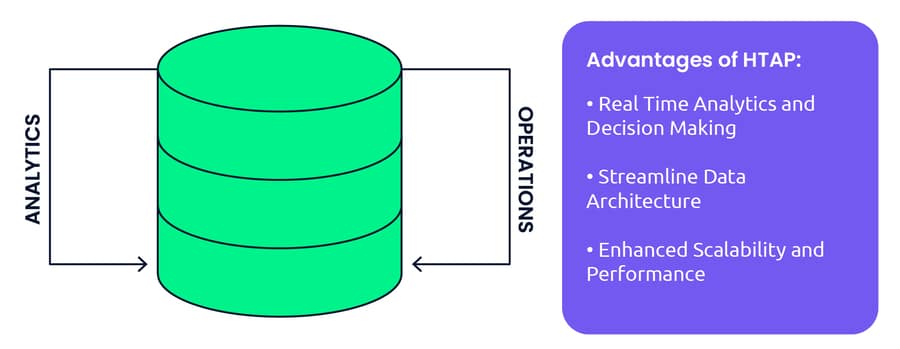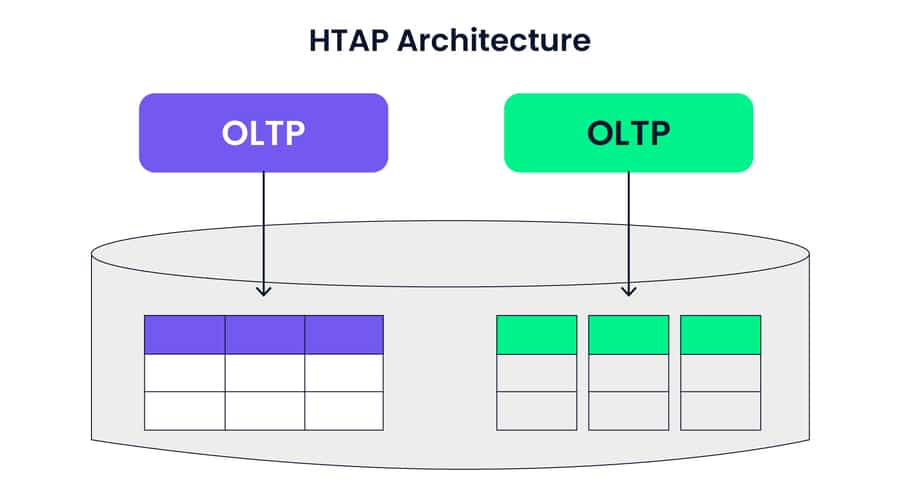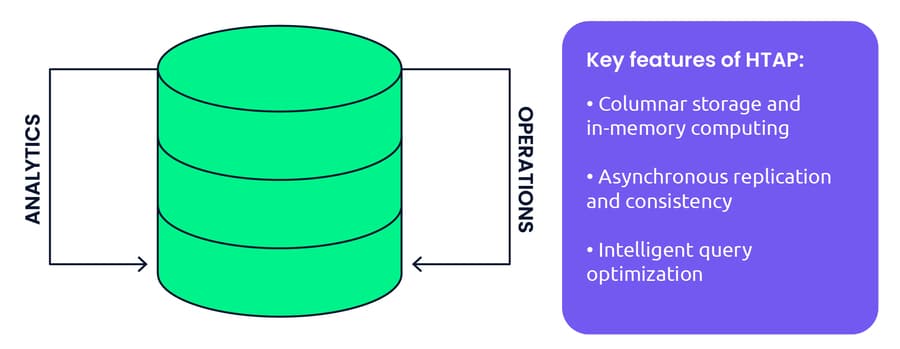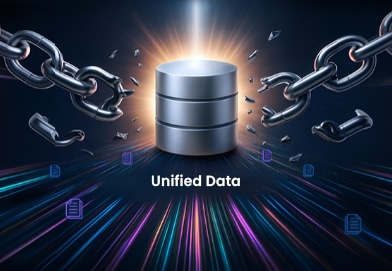Short Summary
- HTAP databases offer a hybrid approach combining OLTP and OLAP for real-time data processing and analytics.
- Organizations can benefit from improved real-time insights, streamlined architecture, scalability & performance with HTAP databases.
- Key features include columnar storage/in-memory computing, asynchronous replication/consistency & intelligent query optimization to maximize the benefits of this hybrid database engine.
Introduction
Imagine a world where the limitations of separate transactional and analytical systems now support data-driven decision-making. A world where real-time insights can be gleaned from vast amounts of data with ease, allowing organizations to capitalize on fleeting opportunities and drive innovation across industries. This is the world of Hybrid Transactional Analytical Processing (HTAP) databases, a powerful alternative to traditional data management solutions.
In this blog post, we’ll dive deep into the world of HTAP databases, exploring their hybrid nature, the advantages of adopting them, their key features, and how to integrate them into your data strategy and real-world use cases across various industries. Are you ready to unlock the potential of HTAP databases in 2023 and revolutionize how you manage and analyze data?
Understanding HTAP Database: A Hybrid Approach

HTAP databases represent a paradigm shift in data management, as they seamlessly integrate transactional processing (OLTP) and analytical processing (OLAP) into a single system. This hybrid approach eliminates the need for two databases tailored to each workload, which previously resulted in data warehouses for OLAP and separate systems for OLTP. The result is a powerful and flexible data platform that can handle both transactional and analytical workloads simultaneously, allowing organizations to harness the power of real-time data processing and analytics.
By utilizing the same replication and sharding mechanism as OLTP architecture, HTAP databases effectively manage transactional data, providing horizontal scalability and storage efficiency. This innovative approach disrupts traditional data architecture and paves the way for a new era of real-time analytics and decision-making.
Online Transactional Processing (OLTP)
OLTP, short for Online Transactional Processing, is a type of data processing that enables the concurrent execution of many small transactions in real-time. Widely utilized for financial transactions, order entry, retail sales, and CRM, OLTP databases employ a row-based storage engine, making them suitable for handling transactional workloads.
The significance of OLTP lies in its ability to process high volumes of transactions quickly and efficiently. However, it falls short when answering complex analytical queries, which is where OLAP comes into play.
Online Analytical Processing (OLAP)
OLAP, or Online Analytical Processing, is a software technology that enables multidimensional data analysis from multiple perspectives. Unlike OLTP, OLAP is designed for analytical workloads, offering users the ability to selectively extract and query data to analyze it from various angles. This capability is crucial for advanced analytics, big data, and business intelligence applications, where real-time insights are paramount.
OLAP databases typically consist of columnar databases, allowing them to handle analytical queries efficiently. While OLAP offers powerful analytical capabilities, it cannot process large volumes of transactions efficiently, which is where HTAP databases come in to bridge the gap between OLTP and OLAP.
The Emergence of HTAP Databases
The emergence of HTAP databases can be attributed to the need for a one-stop solution for transactional and analytical processing. By combining OLTP and OLAP capabilities into a single system, HTAP databases eliminate the need for separate systems and the time-consuming process of moving data between them. This enables organizations to capitalize on time-sensitive opportunities that would otherwise be lost due to the latency in transferring data from an OLTP system to an OLAP database.
Moreover, HTAP databases address the limitations of solutions like operational data stores (ODS), which only partially solve the issue of making transactional data available for analytical queries. HTAP databases open new possibilities for predictive analytics and other advanced analytical use cases by offering real-time or near-real-time data access.
Advantages of Adopting HTAP Database

Adopting an HTAP database brings numerous advantages to organizations, including real-time analytics and decision-making, streamlined data architecture, and enhanced scalability and performance.
Let’s delve deeper into these benefits and understand how they can revolutionize your data management and analytics capabilities.
1. Real-Time Analytics and Decision Making
With this hybrid database engine at your disposal, your organization gains the power to take advantage of real-time insights that traditional data management systems cannot provide. By processing transactions and external data, HTAP databases enable organizations to capitalize on transient opportunities lost due to the time required to transfer data between OLTP and OLAP databases.
Real-time analytics and decision-making capabilities empower organizations to make informed decisions based on the latest data, driving innovation and dramatically improving business outcomes. From fraud detection to demand forecasting and beyond, the possibilities are endless for organizations that harness the power of real-time analytics enabled by HTAP databases.
2. Streamlined Data Architecture

Integrating OLTP and OLAP systems into a single HTAP database provides real-time analytics capabilities and simplifies your data architecture. With only one system to manage, organizations can save time and resources that would otherwise be spent maintaining separate systems for transactional and analytical workloads.
Moreover, a streamlined data warehouse architecture minimizes the complexity of data management, reducing the likelihood of data inconsistencies and inaccuracies. By consolidating your data management systems, your organization can enjoy cost savings, improved efficiency, and a more agile data environment better equipped to adapt to the ever-evolving demands of the digital age.
3. Enhanced Scalability and Performance
One of the most compelling benefits of adopting an HTAP database is its ability to deliver enhanced scalability and performance. As data volumes and workloads grow, HTAP databases can efficiently handle the increased demands, ensuring that your organization can process and analyze large amounts of data in real-time.
By combining the scalability of OLTP systems with the analytical prowess of OLAP systems, HTAP databases offer a powerful solution for organizations that require both transactional processing and advanced analytics capabilities. This combination ensures that your organization’s operational analytics can keep up with the rapid pace of modern business and harness the power of real-time insights to drive innovation and growth.
4. When to Use an HTAP Database
HTAP databases should be used in scenarios in which an organization needs to support both high-speed transactional processing and real-time analytics from a single data source. For CTOs and data teams, this implementation means that there’s no more lag time between operations and insight.
HTAP databases are great for businesses that demand instant decision-making in instances such as fraud detection, personalization engines, or operational dashboards, as they eliminate the need for complex ETL pipelines and duplicate data environments.
They’re also a strong fit for applications with high write/read throughput, like IoT platforms, financial services, and e-commerce systems, where analytical queries run in parallel with transactions without impacting performance.
Additionally, if your data infrastructure is growing too complex for separate OLTP and OLAP systems, HTAP databases are the perfect solution for streamlining your architecture, reducing maintenance overload, and increasing agility.
Key Features of Modern HTAP Databases

Modern HTAP databases boast many key features that set them apart from traditional data management solutions. In this section, we’ll explore the standout features of HTAP databases, including:
– Columnar storage and in-memory computing. – Asynchronous replication and consistency. – Intelligent query optimization.
1. Columnar Storage and In-Memory Computing
Columnar storage is a crucial feature of modern HTAP databases, as it enables efficient data processing and analytics by storing data in columns rather than rows. This column store approach is particularly beneficial for analytical queries, as it allows for faster data retrieval and reduced storage space requirements.
In addition to columnar storage, in-memory computing plays a vital role in the performance of HTAP databases. By storing data in memory, HTAP databases can process and analyze data at lightning-fast speeds, delivering real-time insights that drive dramatic business innovation and growth.
2. Asynchronous Replication and Consistency
Asynchronous replication is another key feature of HTAP databases, ensuring the same data accuracy and reliability across multiple database copies. This approach minimizes the risk of data loss or corruption, providing a solid foundation for real-time analytics and decision-making.
The consistency of an HTAP database is crucial, as it guarantees that the latest data is always available for analysis. By maintaining data consistency, your organization can trust the insights generated by your HTAP database, enabling informed decision-making based on the most up-to-date information.
3. Intelligent Query Optimization
Intelligent query optimization is a standout feature of modern HTAP databases, enabling efficient query execution and resource utilization. By analyzing the structure of each query and selecting the most optimal execution plan, intelligent query optimization ensures that your HTAP database delivers the best possible performance for your analytical and transactional workloads.
This advanced optimization capability allows HTAP DB to easily handle high-volume workloads and complex analytical queries, making them an invaluable asset for organizations that require real-time insights and rapid decision-making.
Integrating HTAP Database into Your Data Strategy
Integrating an HTAP database into your data strategy may seem daunting, but it can be a smooth and rewarding process with the right approach.
This section outlines the key steps to assess compatibility with current systems, develop migration and implementation strategies, and monitor and manage HTAP database performance.
Assessing Compatibility with Current Systems
The first step in integrating an HTAP database into your data strategy is assessing compatibility with your organization’s existing systems. This critical step ensures that the HTAP database seamlessly integrates into your current infrastructure without causing disruptions or compatibility issues.
To assess compatibility, you’ll want to evaluate your current data management systems, identify potential bottlenecks or challenges, and determine the best approach to integrating the HTAP database. By thoroughly assessing compatibility, you can minimize risks and ensure that your organization reaps the full benefits of adopting an HTAP database.
Migration and Implementation Strategies
Once compatibility has been assessed, the next step is to develop migration and implementation strategies to transition to an HTAP database. This process involves evaluating your existing data assets, designing a migration plan, constructing the migration solution, and conducting live tests to ensure a smooth transition.
By carefully planning and executing your migration and implementation strategies, you can mitigate risks, minimize downtime, and foster opportunities for growth and innovation in your organization.
Monitoring and Managing HTAP Database Performance
With your HTAP database in place, ongoing monitoring and management of its performance are crucial to ensure optimal results. By keeping a close eye on performance metrics, you can identify areas for improvement, fine-tune your database configuration, and ensure that your organization continues to benefit from real-time insights and decision-making capabilities.
Effective monitoring and management of HTAP database performance involve regularly assessing query performance, resource utilization, and other key performance indicators (KPIs). By proactively addressing potential issues and optimizing performance, your organization can maximize the value of your HTAP database investment.
Real-World HTAP Database Use Cases

The versatility of HTAP databases makes them a valuable asset across various industries, including financial services, retail and e-commerce, and healthcare and life sciences.
This section explores real-world use cases for HTAP DB in these industries, demonstrating the transformative impact of real-time analytics and decision-making capabilities.
1. Financial Services
In the financial services sector, HTAP databases can be leveraged for various applications, including fraud prevention, process optimization, real-time risk management, security, and transaction processing with analytics. By providing real-time insights into customer behavior, financial transactions, and market trends, HTAP databases can help financial institutions make more informed decisions and stay ahead of the competition.
Moreover, the simplified data management offered by HTAP databases can lead to cost savings and reduced operational complexity for financial organizations. This advantage allows them to focus on delivering innovative products and services to their customers while maintaining a streamlined and efficient data infrastructure.
2. Retail and E-commerce
The retail and e-commerce sectors can greatly benefit from adopting HTAP databases, as they provide real-time insights into customer behavior, product sales, and inventory levels. Organizations can optimize operations, improve customer experiences, and drive revenue growth by leveraging these insights.
Additionally, HTAP databases can be used for fraud prevention, recommendation engines, and detecting sales trends in retail and e-commerce. By offering real-time analytics capabilities and streamlined data architecture, HTAP databases enable organizations to be more agile and responsive to market changes and customer preferences.
3. Healthcare and Life Sciences
In the healthcare and life sciences industry, HTAP databases offer the potential to provide real-time insights into patient health, medical treatments, and drug efficacy. These insights can be used to optimize patient care, streamline clinical trials, and accelerate drug discovery programs.
Furthermore, HTAP databases can handle vast amounts of data and deliver performance equivalent to or better than in-memory databases, making them an ideal solution for managing the significant data volumes common in healthcare and life sciences applications.
By harnessing the power of real-time analytics, healthcare organizations can improve patient outcomes, reduce costs, and drive innovation in the industry.
Conclusion
In conclusion, HTAP databases offer a powerful, flexible solution for organizations embracing real-time analytics and decision-making capabilities. By combining the best OLTP and OLAP systems into a single, streamlined platform, HTAP databases can transform how businesses manage and analyze data, driving innovation and growth across various industries.
As we move into an increasingly data-driven world, adopting HTAP databases will undoubtedly become more prevalent. With their unique blend of transactional processing and advanced analytics capabilities, HTAP databases have the potential to revolutionize the way organizations harness the power of data, leading to a brighter and more informed future.
Frequently Asked Questions
What is HTAP vs OLAP vs OLTP?
HTAP, OLTP, and OLAP are all types of databases. HTAP databases can perform both transactional and analytical processing, while OLTP is a single database used for transactional workloads, and OLAP is used for analytics.
In summary, HTAP is a combination of OLTP and OLAP to simultaneously process both kinds of workloads.
What does HTAP stand for?
HTAP stands for Hybrid Transaction/Analytics Processing, a data storage approach that combines transactions and analytics to provide users with speed and simplicity. HTAP databases are ideal for organizations that streamline workloads and optimize data handling.
What is HTAP architecture?
HTAP architecture is a database architecture that combines online transaction processing (OLTP) and online analytical processing (OLAP). It enables faster decision-making by allowing transactions and analytics to be run on the same system.
It provides businesses with real-time insights to react quickly to customer needs.
What is the difference between an analytical and a transactional database?
Analytical databases are optimized for efficient data aggregation and mining, whereas transactional databases are designed to handle day-to-day operations efficiently. In short, analytical databases provide insight into large datasets, while transactional databases provide a reliable operational foundation.
What is the meaning of hybrid transactional and analytical processing?
Hybrid transactional and analytical processing (HTAP) is a data architecture that combines the capabilities of online transaction processing (OLTP) and online analytical processing (OLAP), enabling both sets of workloads to be handled in one system for greater speed and simplicity.
This architecture allows for faster and simpler processing of OLTP and OLAP workloads, providing businesses a more efficient way to manage their data.







